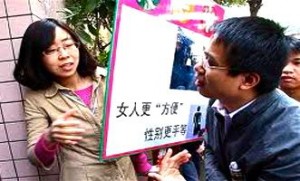Demanding Toilet Justice for the Women of China
NOVEMBER 19, 2014

The battle for bathroom justice for Chinese women took on new life on Wednesday, as activists rallied across the country to demand that the government mandate that more women’s toilets be made available.
The campaign was part ofWorld Toilet Day, which seeks to raise international awareness about insufficient access to sanitation. To mark the day, a group of 23 Chinese students, architects and engineers petitioned the government to revise its 2013 Standard for City Public Toilet Design, draft legislation that calls for 1.5 women’s toilets for every men’s toilet. The petitioners want that ratio raised to two-to-one, and they want more space in individual stalls in women’s restrooms.
“This was the minimum request of ‘Occupy Men’s Rooms,’ ” said Li Tingting, who initiated this year’s petition, referring to a 2012 campaign calling for more women’s toilets in Chinese cities. “We hope the relevant departments can improve the legislation as soon as possible, and resolve the difficulties women face in going to the bathroom.”
The petitioners, who included men, called on the Ministry of Housing and Urban-Rural Development and other departments to take into account the physiology of women — which they say means that women spend an average of 89 seconds on each bathroom visit, compared with 39 seconds for men — and the fact that more women accompany their children to the restroom.
Moreover, the petition said, citing a study by Cornell University, pregnant women and menstruating women have to visit the bathroom for a significantly longer time.
Citing Taiwan, Shanghai and Beijing, the petition argued that gender equality on access to toilets was already accepted practice in some facilities in major localities. In Taiwan, the letter said, the 2006 Architectural Technique Regulation requires public bathrooms in vehicle rest areas, schools and movie theaters to use a three-to-one ratio of women’s to men’s toilets.
In Shanghai, the World Expo in 2010 used a ratio of 2.5 to one in setting up new bathrooms. And in 2008, when Beijing hosted the Olympics Games, the 60 temporary toilets set up at the Temple of Heaven, a popular tourist destination in southeastern Beijing, used a ratio of four to one.
“In my own work, I always use a two-to-one ratio to design women’s and men’s bathrooms, because, as a woman, I feel that the current system is clearly not reasonable,” said Feng Bifeng, an engineer and one of the petitioners. “In the women’s toilets, you always have traffic. Changing the bathroom ratio is the only way society can show concern for women.”
The petitioners’ call for toilet justice quickly attracted a following on Sina Weibo, the microblogging service.
“You have to wait forever in line in a women’s toilet. I occasionally use the men’s toilet for a quick fix!” one user admitted.
This year’s initiative may have lacked some of the color of the Occupy Men’s Bathroom campaign in 2012, which featured protesters showing up at Guangzhou’s government offices, chanting, “Bathroom ratio two to one, or else women won’t hold it!”
But Ms. Li, who started Wednesday’s petition, noted that this year, photos of supporters across China holding signs reading “2:1″ were posted online.
“I’ve been paying attention to this toilet issue for years, and feel there aren’t enough people paying attention to it in China,” she said in an interview on Wednesday. “So I often think, if not me, who?”
She threatened further action if the government did not respond to the petitioners’ demand in a satisfactory manner.
“If Beijing, Shanghai, Guangzhou and Shenzhen don’t build more women’s toilets and fix their ratio, I’ll wear short pants and roll around in Yuexiu Park” she said, referring to an area in Guangzhou.
“The situation is too nerve-racking,” Ms. Li said. “The government hasn’t taken any action on this. It’s enough to make one roll in circles.”
No comments:
Post a Comment
Comments always welcome!